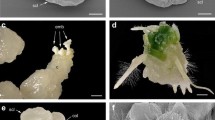Summary
Embryogenesis was analyzed in wheat × maize hybrids using paraffin sectioning. Embryogenesis in wheat × maize hybrids is different from that in self-pollinated wheat plants. Development of the embryo is not accompanied by the formation of an endosperm. The endosperm nuclei remain free in the cytoplasm, fail to advance into the cellular stage, and degenerate at a later time. The antipodal cells quickly degenerate in the fertilized ovaries of wheat × maize hybrids similar to self-pollinated ovaries. The antipodal cells remain normal in unpollinated ovaries. The pre-embryo will abort if it is allowed to develop on the plant, because of a nutritional shortage in the absence of an endosperm. Therefore, embryo rescue is necessary for haploid production from a wheat × maize hybrids. Haploid polyembryos were obtained from spikelet culture of wheat × maize hybrids. The formation of polyembryos is due to the cleavage of the pre-embryo and the effect of 2,4-D. The frequency of haploid embryo production and plant regeneration is affected significantly by maize genotypes, but not by wheat genotypes. The concentration of 2,4-D affects only the size of the embryo.
Similar content being viewed by others
References
Barclay I.R., 1975. High frequencies of haploid production in wheat (Triticum aestivum) by chromosome elimination. Nature 256: 410–411.
Berlyn G.P. & J.P. Miksche, 1976. Botanical microtechnique and cytochemistry. pp. 24–85. The Iowa State University Press, Ames.
Brink R.A. & D.C. Cooper, 1944. The antipodals in relation to abnormal endosperm behavior in Hordeum jubatum × scereale hybrid seeds. Genetics 29: 391–406.
Bryant J.A., 1985. Seed Physiology. The Camelot Press Ltd, Southampton, UK. pp. 1–15.
Inagaki M. & M. Tahir, 1990. Comparison of haploid production frequencies in wheat varieties crossed with Hordeum bulbosum L. and maize. Jpn J Breed 40: 209–216.
Kisana N.S., K.K. Nkongolo, J.S. Quick & D.L. Johnson, 1993. Production of doubled haploids by anther culture and wheat × maize method in a wheat breeding program. Plant Breeding 110: 96–102.
Lakshmanan K.K. & K.B. Ambegaokar, 1982. Experimental embryology of vascular plants. pp. 445–474. Springer-Verlag, New York.
Laurie D.A. & M.D. Bennett, 1986. Wheat × maize hybridization. Can J Genet Cytol 28: 313–316.
Laurie D.A. & M.D. Bennett, 1988. The production of haploid wheat plants from wheat × maize crosses. Theor Appl Genet 76: 393–397.
Laurie D.A. & M.D. Bennett, 1989. The timing of chromosome elimination in hexaploid wheat × maize crosses. Genome 32: 953–961.
Laurie D.A., 1989. Factors affecting fertilization frequency in crosses of Triticum aestivum cv. ‘Highbury’ × Zea mays cv. ‘Seneca 60’. Plant Breeding 103: 133–140.
Laurie D.A. & S. Reymondie, 1991. High frequencies of fertilization and haploid seedling production in crosses between commercial hexaploid wheat varieties and maize. Plant Breeding 106: 182–189.
Murashige O. & F. Skoog, 1962. A revised medium for rapid growth and bio assays with tobacco tissue cultures. Physiologia Plantarum 15: 473–497.
Odenbach W., 1964. Histologische und cytologische Untersuchungen der Entwicklungsvorgänge nach der Bestäubung von Gerste mit Roggen. Z Pflanzenzüchtg 53: 1–52.
Pienaar R.V.de & D. Lesch, 1994. Doubled haploids (DH). Ann Wheat Newslett 40: 202–204.
Riera-Lizarazu O. & A. Mujeeb-Kazi, 1990. Maize (Zea mays L.) mediated wheat (Triticum aestivum L.) polyhaploid production using various crossing methods. Cereal Res Commun 18: 339–345.
Sarkar K.R. & E.H.Jr. Coe, 1966. A genetic analysis of the origin of maternal haploids in maize. Genetics 54: 453–464.
Suenaga K. & K. Nakajima, 1989. Efficient production of haploid wheat (Triticum aestivum) through crosses between Japanese wheat and maize (Zea mays). Plant Cell Rep 8: 263–266.
Suenaga K. & J. Nakajima, 1993. Variation in doubled haploid plants of wheat obtained through wheat (Triticum aestivum) × maize (Zea mays) crosses. Plant Breeding 111: 120–124.
Zee S.Y. & G. Zhu, 1982. Wheat anatomy. Beijing University Press, China. pp. 37–62.
Author information
Authors and Affiliations
Rights and permissions
About this article
Cite this article
Zhang, J., Friebe, B., Raupp, W.J. et al. Wheat embryogenesis and haploid production in wheat × maize hybrids. Euphytica 90, 315–324 (1996). https://doi.org/10.1007/BF00027482
Received:
Accepted:
Issue Date:
DOI: https://doi.org/10.1007/BF00027482




